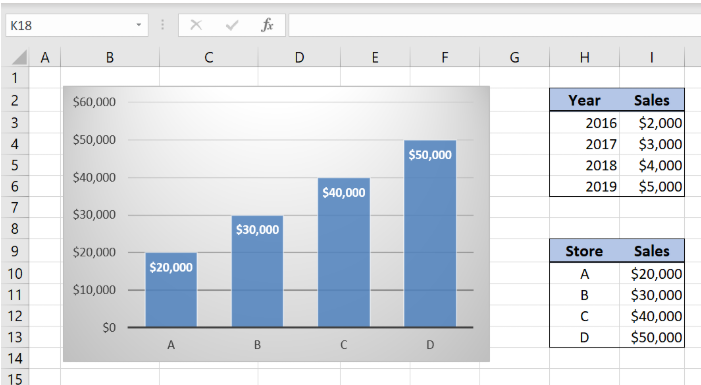

Re: Excel Chart Duplicate Labels on X-Axis. The above method works great when you have already created the chart and you want to swap the axis.īut if you haven’t created the chart already, one way could be to rearrange the data so that Excel picks up the data and plots it on the X and Y axis as per your needs.Įxcel by default sets the first column of the data source on the X-axis, and the second column on the Y-axis. Click the title you want to link and, while it is selected, click in the Formula bar. If you want to aggregate all the data for Dept 1 for example, then you require a pivot chart rather than a regular chart, or some sort of summary table using formulas. Now select the cell you want to link the title to by clicking it. A pivot chart would be the simplest option as it will only need a few mouse clicks to set up.

In this case, you can just move Quantity in column B, and Sales in column C. Theres no learning curve youll get a beautiful graph or diagram in minutes. Switching the axis option in a chart gives you more flexibility for adjusting the chart axis. Next well create the X and Y axis lines as well as the horizontal. The end result is you eliminate the labels overlapping the chart and it is easier to understand what you are seeing. Also, this way you don’t need to change any data in your sheet. However, we can just as easily change the y-axis scale by right-clicking on any of the values on the y-axis and performing the same steps as above.So these are two simple and easy ways to switch the axis in Excel charts. Note that in these examples, we chose to change only the x-axis scale.

Related: When Should You Use a Log Scale in Charts? The x-axis will automatically be updated to use a logarithmic scale: Because the scale of the line chart's horizontal (category) axis cannot be changed as much as the scale of the vertical (value) axis that is used in the xy (scatter) chart, consider using an xy (scatter) chart instead of a line chart if you have to change the scaling of that axis, or display it as a logarithmic scale. In the Format Axis panel, simply check the box next to Logarithmic scale: Instead of changing the minimum and maximum bounds, we could also choose to use a logarithmic scale for the axis instead. Notice that the x-axis now ranges from 0 to 50. Once we press Enter, the x-axis scale will automatically be updated on the plot: In the Format Axis panel that appears on the right side of the screen, change the values in the Minimum and Maximum boxes to change the scale of the x-axis.įor example, we could change the Maximum value of the x-axis to 50: In the dropdown menu that appears, click Format Axis: To change the scale of the x-axis, simply right click on any of the values on the x-axis. In this example, we can see that the x-axis ranges from 0 to 20 and the y-axis ranges from 0 to 30. The following scatterplot will automatically be created:īy default, Excel will choose a scale for the x-axis and y-axis that ranges roughly from the minimum to maximum values in each column. Go ahead based on your Microsoft Excel's version: (1) In Excel 2013's Format Axis pane, expand the Labels on the Axis Options tab, click the Label Position box and select Low from the drop down list (2) In Excel 20's Format Axis. Then click the Insert tab along the top ribbon and then click the Scatter option within the Charts group: Right click the X axis in the chart, and select the Format Axis from the right-clicking menu. Next, highlight the cells in the range A2:B16. Step 1: Enter the Dataįirst, let’s enter a simple dataset into Excel:
Excel 2016 mac move vertical axis how to#
This tutorial provides a step-by-step example of how to change the x-axis and y-axis scales on plots in Excel.


 0 kommentar(er)
0 kommentar(er)
